Deer are adorable wild creatures! However, more and more deer lose their fear of people and travel to urban areas looking for food around people’s houses. While you won’t mind finding a deer in your garden and feeding it, this can, in fact, harm the deer population.
Moreover, since deer are wild animals, they can carry diseases or parasites that can be spread to humans and pets, so keeping them at a distance is better than inviting them in.
In short, your family and the deer population will benefit if you make your garden deer-proof. Keep reading to learn about the best deer-resistant shrubs you can grow in your garden!

1. Boxwood
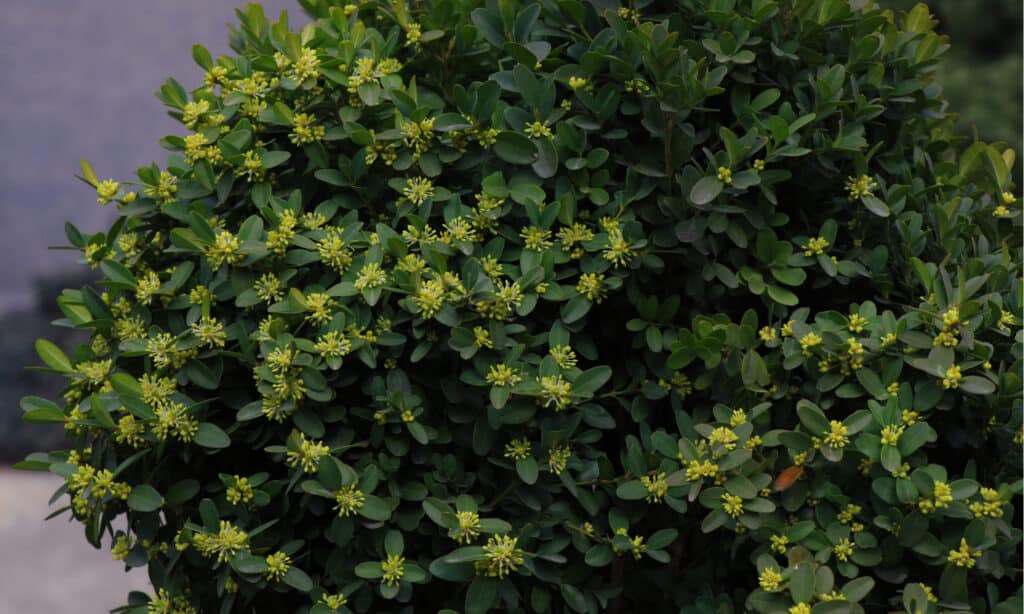
Boxwood plants are evergreen shrubs or small trees that grow between 6.6 and 39.4 feet tall.
©Antoniya Kadiyska/Shutterstock.com
| Boxwood | |
|---|---|
| Scientific name | Buxus (Genus) |
| Plant type | Evergreen shrubs or small trees |
| USDA Hardiness zones | 5 to 9 |
| Soil needs | Well-drained, sandy loam |
| Sun exposure | Partial shade to full sun |
Boxwood is the term used for roughly 70 species in the Buxus genus, meaning you have many types to choose from. These plants are commonly called boxes.
Boxwood plants are evergreen shrubs or small trees that grow between 6.6 and 39.4 feet tall. Their leaves are rounded to lanceolate and small. The flowers are small, too, and they have a yellow-green color.
Boxes are extremely popular among homeowners because they make good hedges and require low maintenance. The fact that they are deer-resistant only adds another advantage to their uses!
2. Butterfly Bush

The butterfly bush is scientifically called
Buddleja davidii.
©iStock.com/lantapix
| Butterfly Bush | |
|---|---|
| Scientific name | Buddleja davidii (species) |
| Plant type | Semi-evergreen shrubs |
| USDA Hardiness zones | 5 to 10 |
| Soil needs | Well-drained, medium moist soil, slightly acidic to neutral |
| Sun exposure | Full sun |
The butterfly bush is scientifically called Buddleja davidii. People may also call it summer lilac or orange eye. However, there are other species in the genus that you may opt for as deer-resistant shrubs.
It’s a flowering shrub native to China and Japan and is one of the most popular ornamental plants among gardeners. It has an arching habit and may grow up to 16 feet tall.
Besides being an excellent deer-resistant shrub, it’s perfect for decorating your garden, thanks to the beautiful flowers it produces. Moreover, these flowers attract pollinators, so your house will undoubtedly be surrounded by incredibly beautiful butterflies! Many people choose butterfly bushes for their gardens for their pleasant smell, too.
However, don’t forget that these plants cannot survive temperatures lower than −4 °F.
3. Juniper
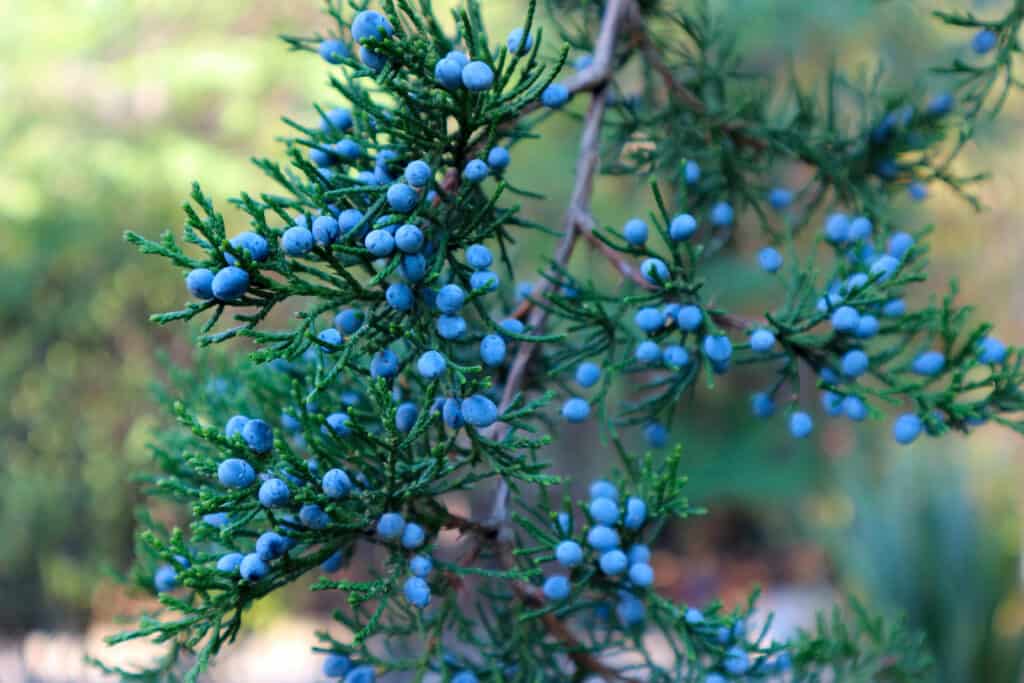
Junipers are low maintenance, usually requiring only pruning to control growth.
©iStock.com/Lyudmila Chetvertnykh
| Juniper | |
|---|---|
| Scientific name | Juniperus (genus) |
| Plant type | Evergreen shrubs or trees |
| USDA Hardiness zones | 2 to 10 |
| Soil needs | Well-drained, wide range of pH levels, dry clay soils |
| Sun exposure | Full sun |
Junipers form the Juniperus genus of evergreen trees and shrubs. You can choose among the 50 to 70 juniper species to decorate your garden! However, many juniper species grow very tall, so we recommend choosing a smaller species, such as the blue star juniper, blue rug juniper, or Pfitzer Chinese juniper.
Since junipers emanate a strong smell, deer won’t even dare approach them, as their sense of smell is extremely sensitive. These plants are low maintenance, usually requiring only pruning to control growth. Gardeners often choose junipers for their high tolerance to heat and because they can be used as screens, ground covers, windbreaks, and foundation plants.
4. Forsythia
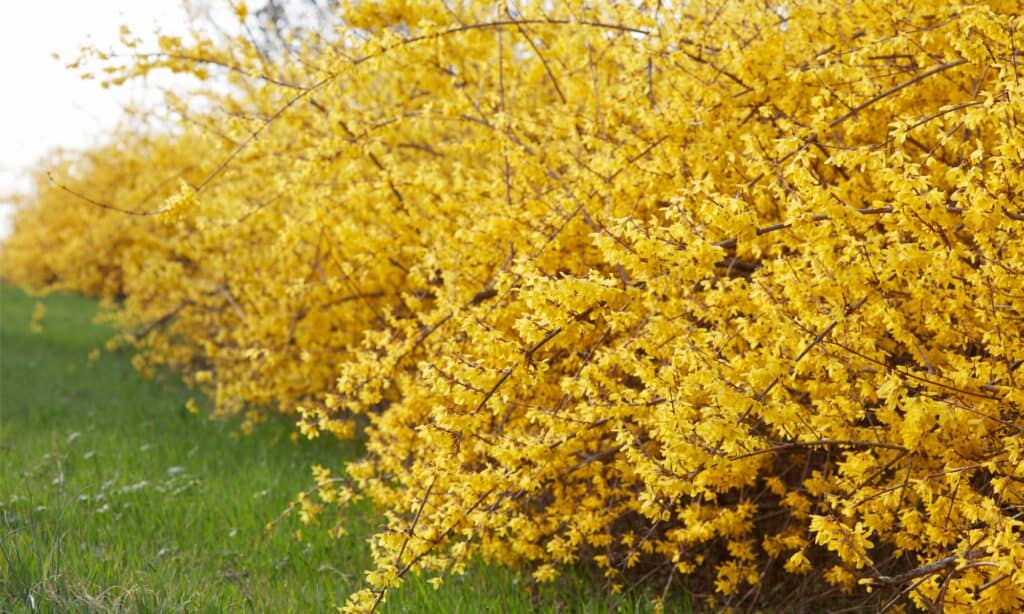
Forsythia plants are flowering shrubs native to eastern Asia and southeastern Europe.
©iStock.com/AndreaAstes
| Forsythia | |
|---|---|
| Scientific name | Forsythia (genus) |
| Plant type | Deciduous shrubs |
| USDA Hardiness zones | 5 to 8 |
| Soil needs | Adapts to different types of soils but prefers loose, well-draining soil with a neutral or slightly alkaline pH ranging between 7.0 and 8.9 |
| Sun exposure | Partial shade to full sun |
Forsythia plants are flowering shrubs native to eastern Asia and southeastern Europe. The genus has around 11 species that, on average, grow between 3 and 9 feet tall. The plants bloom in early spring and produce bright yellow flowers. If you’re looking for a plant to color your garden during spring, choose forsythia. Besides this, the plants in this genus are excellent at keeping deer away from your house.
If you’re not sure which forsythia to choose, you can opt for Forsythia suspensa and Forsythia viridissima, two hybrid species gardeners prefer.
5. Japanese Andromeda

Japanese andromeda is a flowering shrub in the
Pierisgenus.
©MIROFOSS/Shutterstock.com
| Japanese Andromeda | |
|---|---|
| Scientific name | Pieris japonica (species) |
| Plant type | Evergreen shrubs |
| USDA Hardiness zones | 5 to 8 |
| Soil needs | Slightly acidic, moist but well-drained soil |
| Sun exposure | Partial shade to full sun |
Japanese andromeda is a flowering shrub in the Pieris genus. It’s a medium-sized evergreen shrub plant enthusiasts often choose for their gardens.
On average, Japanese andromeda plants grow 3.3 to 13.1 feet tall and produce white or pink flowers in early spring. If you choose this species, it will give your garden a breathtaking appearance during those three weeks in which flowers are in full bloom.
However, there’s an essential aspect you should consider. While it can help keep deer away from your garden, Japanese andromeda is poisonous to humans and other animals. Ingested flowers or leaves may cause excessive salivation, vomiting, cardiac failure, and even death. So if you choose this shrub for your garden, you should plant it in a spot your children and pets cannot reach.
6. Russian Sage
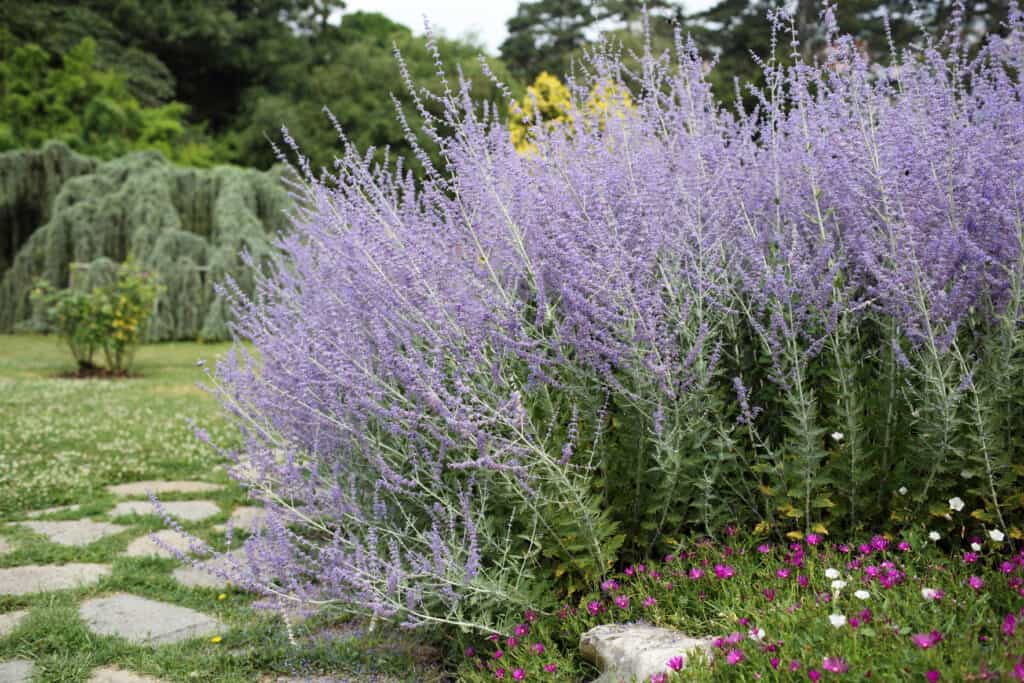
Russian sage is an evergreen subshrub.
©iStock.com/loflo69
| Russian Sage | |
|---|---|
| Scientific name | Salvia yangii (species) |
| Plant type | Deciduous subshrubs |
| USDA Hardiness zones | 3 to 9 |
| Soil needs | It can adapt to various soil types but prefers sandy, chalky, or loamy soils |
| Sun exposure | Full sun |
Russian sage is an evergreen subshrub or, as others call it, a dwarf shrub. It grows up to 4 feet tall, has gray-green leaves, and distinctive blue-to-violet flowers that bloom from mid-summer to late October.
If crushed, Russian sage leaves give off a strong odor that keeps deer away.
Moreover, it’s an excellent garden plant not only because it’s deer-resistant. Russian sage is also rabbit-resistant, drought-tolerant, and doesn’t require much maintenance!
7. Bluebeard
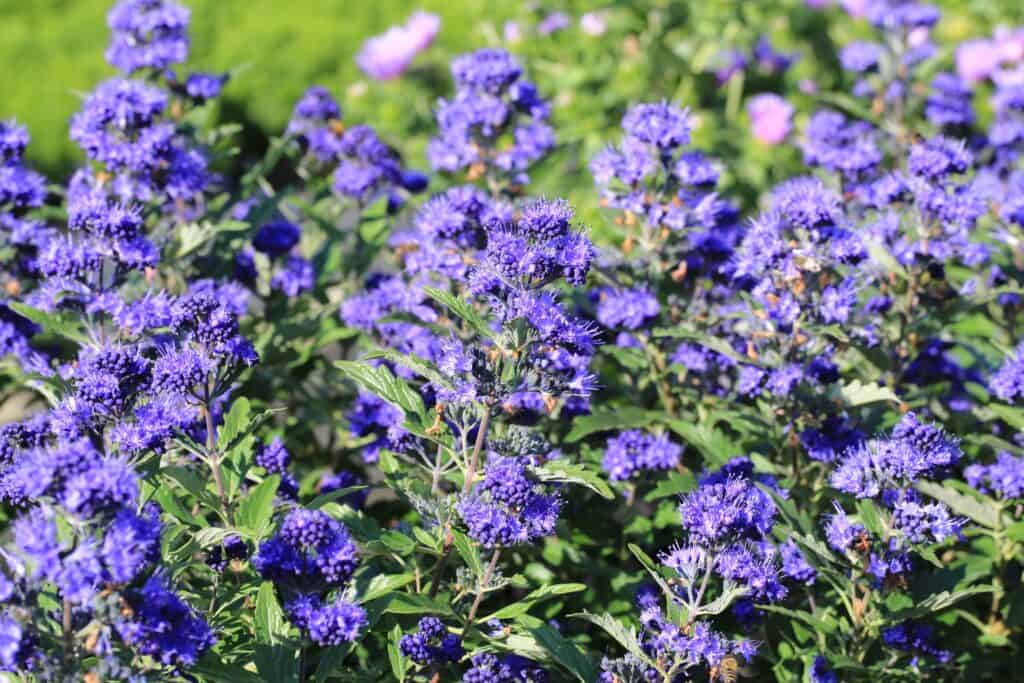
Bluebeard shrubs produce blue or white flowers in late summer.
©Traveller70/Shutterstock.com
| Bluebeard | |
|---|---|
| Scientific name | Caryopteris (genus) |
| Plant type | Herbaceous shrubs |
| USDA Hardiness zones | 5 to 9 |
| Soil needs | Well-drained soils; medium moisture |
| Sun exposure | Full sun |
Bluebeard shrubs produce blue or white flowers in late summer. During that time, your garden will be full of pollinators, so you’ll have a stunning view of multiple bees and butterflies flying around your house! Moreover, deer will stay far from your garden since bluebeards have a specific fragrance!
Bluebeards are drought-tolerant and thrive in Zones 5-9 and well-drained, medium-moist soils.
8. Arrowwood Viburnum
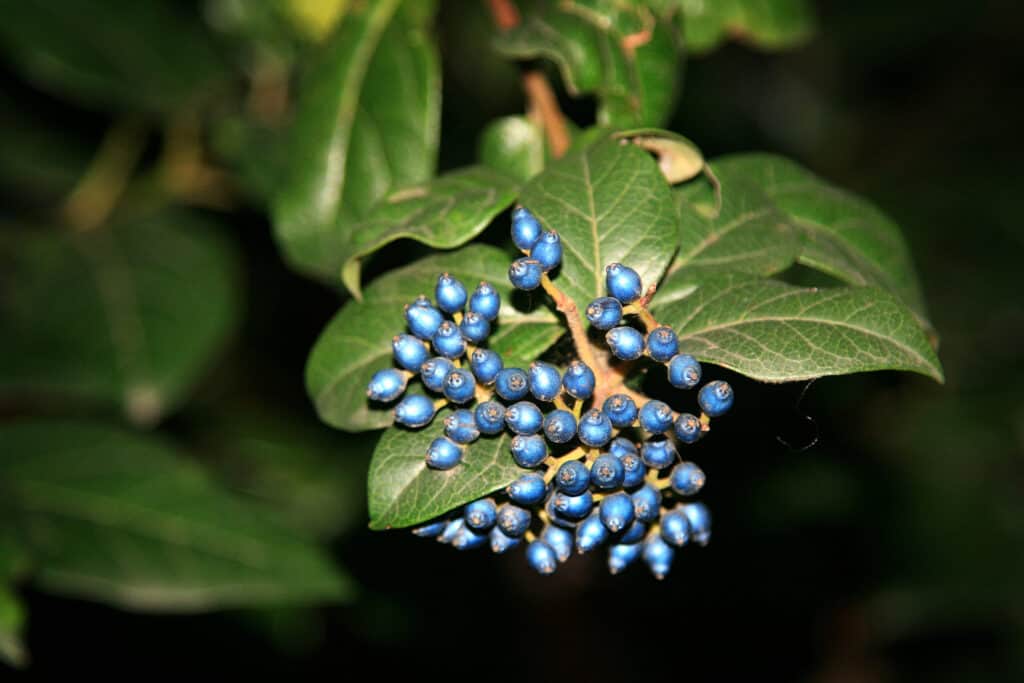
Viburnum dentatum plants produce blueberry-like drupes that are a primary food source for songbirds.
©photosbelkina/Shutterstock.com
| Arrowwood viburnum | |
|---|---|
| Scientific name | Viburnum dentatum (species) |
| Plant type | Deciduous shrubs |
| USDA Hardiness zones | 2 to 10 |
| Soil needs | Well-drained soils; adapts to a wide range of pH levels; prefers dry, clay soils |
| Sun exposure | Full sun |
Viburnum dentatum plants are called arrowwood viburnum, southern arrowwood, or roughish arrowwood. They have opposite, simple leaves which turn yellow to red towards the end of autumn.
They produce blueberry-like drupes that are a primary food source for songbirds. So if you live in an area where songbirds are found, you can rest assured that these beautifully colored birds won’t resist visiting your garden!
These shrubs can grow up to 10 feet or even taller if properly cared for. Pruning the shrub once a year will help control its height.
9. Weigela

is a genus of deciduous shrubs that can reach 15 feet in height.
©krolya25/Shutterstock.com
| Weigela | |
|---|---|
| Scientific name | Weigela (genus) |
| Plant type | Deciduous shrubs |
| USDA Hardiness zones | 4 to 8 |
| Soil needs | Moist but well-drained soils; sand, clay, chalk, or loam soils; slightly acidic soils |
| Sun exposure | Partial shade to full sun |
Weigela is a genus of deciduous shrubs that can reach 15 feet in height. They have long, ovate-oblong leaves and five-lobed red, pink, or white flowers. While not all species are popular as ornamental plants, you can choose one among the ones available on the market, especially among the cultivars that received the Royal Horticultural Society’s Award of Garden Merit:
- Weigela florida ‘Alexandra’
- Weigela ‘Red Prince’
- Weigela ‘Praecox Variegata’
- Weigela ‘Florida Variegata.’
Besides being deer-resistant, these flowers are perfect for covering your garden and creating a private space.
10. Lilac

Some lilac species may have pale yellow, pink, white, or dark burgundy flowers.
©NikolayTsyu/Shutterstock.com
| Lilac | |
|---|---|
| Scientific name | Syringa (genus) |
| Plant type | Evergreen or deciduous shrubs |
| USDA Hardiness zones | 3 to 7 |
| Soil needs | Well-drained soil; prefers soils based on chalk; alkaline to neutral soils |
| Sun exposure | Partial shade to full sun |
The Syringa genus has 12 recognized lilac species you can choose from to decorate your garden. These shrubs produce pretty purple flowers that bloom in spring. Some species may have pale yellow, pink, white, or dark burgundy flowers. Besides having a pleasant appearance, they have a delicate, enjoyable smell which, fortunately, keeps deer away!
If you don’t know what species to choose, you can go for Syringa vulgaris, called common lilac, which is the most popular among plant enthusiasts. It is a deciduous shrub that produces lilac to mauve flowers.
Summary of 10 Best Deer-Resistant Shrubs
Here’s a recap of the 10 top shrubs to plant in your garden that can help deter deer.
| Number | Shrub | Scientific Name | USDA Hardiness Zones |
|---|---|---|---|
| 1 | Boxwood | Buxus (Genus) | 5 to 9 |
| 2 | Butterfly Bush | Buddleja davidii (species) | 5 to 10 |
| 3 | Juniper | Juniperus (genus) | 2 to 10 |
| 4 | Forsythia | Forsythia (genus) | 5 to 8 |
| 5 | Japanese Andromeda | Pieris japonica (species) | 5 to 8 |
| 6 | Russian Sage | Salvia yangii (species) | 3 to 9 |
| 7 | Bluebeard | Caryopteris (genus) | 5 to 9 |
| 8 | Arrowwood Viburnum | Viburnum dentatum (species) | 2 to 10 |
| 9 | Weigela | Weigela (genus) | 4 to 8 |
| 10 | Lilac | Syringa (genus) | 3 to 7 |
The photo featured at the top of this post is © Photophlox/Shutterstock.com
Sources
- The Spruce, Available here: https://www.thespruce.com/deer-resistant-shrubs-4150767
- Pure Wow, Available here: https://www.purewow.com/home/deer-resistant-shrubs
- Monrovia, Available here: https://www.monrovia.com/be-inspired/18-beautiful-deer-resistant-shrubs.html
- University of Massachusetts Amherst, Available here: https://ag.umass.edu/landscape/fact-sheets/juniper-culture
Thank you for reading! Have some feedback for us? Contact the AZ Animals editorial team.






